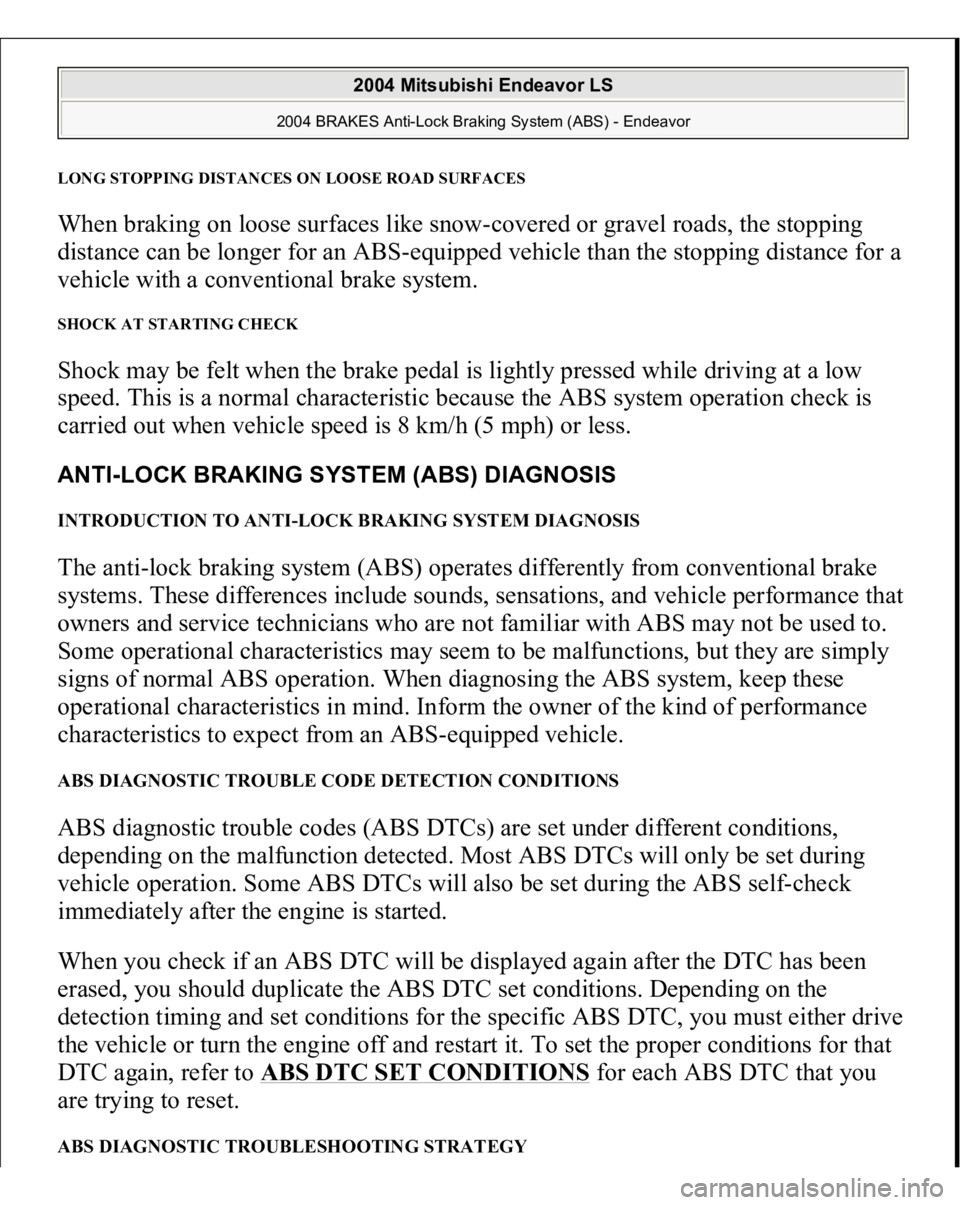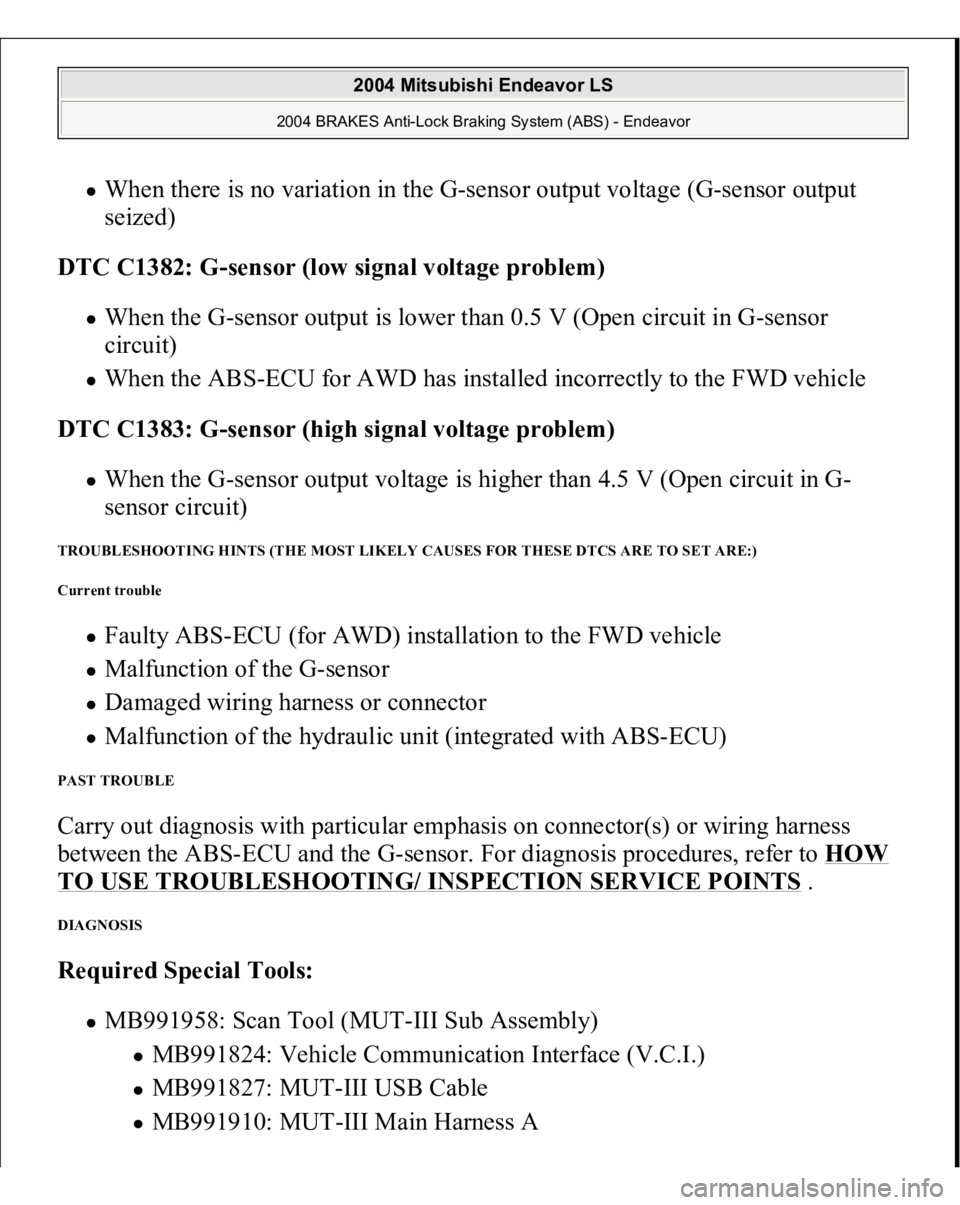Page 1 of 3870

2004 BRAKES
Anti-Lock Braking System (ABS) - Endeavor
GENERAL DESCRIPTION FEATURES The 4ABS ensures directional stability and control during hard braking.
This ABS uses a 4-sensor 4-channel system that controls all four wheels
independently of each other. The basic system is the same as that for the Lancer.
EBD (Electronic Brake-force Distribution system) control has been installed to
provide the ideal braking force for the rear wheels.
EBD CONTROL In ABS, electronic control is used so the rear wheel brake hydraulic pressure during
braking is regulated by rear wheel control solenoid valves in accordance with the
vehicle's rate of deceleration. The front and rear wheel slippages are calculated from
the signals received from the various wheel sensors. EBD control is a control
system which provides a high level of control for both vehicle braking force and
vehicle stability. The system has the following features:
To shorten the harness wires and enhance data transmission reliability,
communication with other ECU is performed over a CAN (Controller Area
Network). Fail-safe function ensures that safety is maintained. Diagnostic function provides improved serviceability. Because the system provides the optimum rear wheel braking force regardless
of vehicle load and the condition of the road surface, the system reduces the
required pedal depression force, particularly when the vehicle is heavily
loaded. Because the duty placed on the front brakes is reduced, the increases in pad
temperature can be controlled during front brake application to improve pad
wear.
2004 Mitsubishi Endeavor LS
2004 BRAKES Anti-Lock Braking System (ABS) - Endeavor
2004 Mitsubishi Endeavor LS
2004 BRAKES Anti-Lock Braking System (ABS) - Endeavor
Page 4 of 3870

LONG STOPPING DISTANCES ON LOOSE ROAD SURFACESWhen braking on loose surfaces like snow-covered or gravel roads, the stopping
distance can be longer for an ABS-equipped vehicle than the stopping distance for a
vehicle with a conventional brake system. SHOCK AT STARTING CHECK Shock may be felt when the brake pedal is lightly pressed while driving at a low
speed. This is a normal characteristic because the ABS system operation check is
carried out when vehicle speed is 8 km/h (5 mph) or less. ANTI-LOCK BRAKING SYSTEM (ABS) DIAGNOSIS INTRODUCTION TO ANTI-LOCK BRAKING SYSTEM DIAGNOSIS The anti-lock braking system (ABS) operates differently from conventional brake
systems. These differences include sounds, sensations, and vehicle performance that
owners and service technicians who are not familiar with ABS may not be used to.
Some operational characteristics may seem to be malfunctions, but they are simply
signs of normal ABS operation. When diagnosing the ABS system, keep these
operational characteristics in mind. Inform the owner of the kind of performance
characteristics to expect from an ABS-equipped vehicle. ABS DIAGNOSTIC TROUBLE CODE DETECTION CONDITIONS ABS diagnostic trouble codes (ABS DTCs) are set under different conditions,
depending on the malfunction detected. Most ABS DTCs will only be set during
vehicle operation. Some ABS DTCs will also be set during the ABS self-check
immediately after the engine is started.
When you check if an ABS DTC will be displayed again after the DTC has been
erased, you should duplicate the ABS DTC set conditions. Depending on the
detection timing and set conditions for the specific ABS DTC, you must either drive
the vehicle or turn the engine off and restart it. To set the proper conditions for that
DTC again, refer to ABS DTC SET CONDITIONS
for each ABS DTC that you
are trying to reset.
ABS DIAGNOSTIC TROUBLESHOOTING STRATEGY
2004 Mitsubishi Endeavor LS
2004 BRAKES Anti-Lock Braking System (ABS) - Endeavor
Page 146 of 3870

When there is no variation in the G-sensor output voltage (G-sensor output
seized)
DTC C1382: G-sensor (low signal voltage problem) When the G-sensor output is lower than 0.5 V (Open circuit in G-sensor
circuit) When the ABS-ECU for AWD has installed incorrectly to the FWD vehicle
DTC C1383: G-sensor (high signal voltage problem) When the G-sensor output voltage is higher than 4.5 V (Open circuit in G-
sensor circuit)
TROUBLESHOOTING HINTS (THE MOST LIKELY CAUSES FOR THESE DTCS ARE TO SET ARE:)
Current trouble
Faulty ABS-ECU (for AWD) installation to the FWD vehicle Malfunction of the G-sensor Damaged wiring harness or connector Malfunction of the hydraulic unit (integrated with ABS-ECU)
PAST TROUBLE Carry out diagnosis with particular emphasis on connector(s) or wiring harness
between the ABS-ECU and the G-sensor. For diagnosis procedures, refer to HOW TO USE TROUBLESHOOTING/ INSPECTION SERVICE POINTS
.
DIAGNOSIS Required Special Tools:
MB991958: Scan Tool (MUT-III Sub Assembly)
MB991824: Vehicle Communication Interface (V.C.I.) MB991827: MUT-III USB Cable MB991910: MUT-III Main Harness A
2004 Mitsubishi Endeavor LS
2004 BRAKES Anti-Lock Braking System (ABS) - Endeavor
Page 247 of 3870
Fig. 146: Identifying Special Tools (2 Of 2)
Courtesy of MITSUBISHI MOTOR SALES OF AMERICA.
ON-VEHICLE SERVICE ABS SENSOR OUTPUT VOLTAGE MEASUREMENT Required Special Tool:
MB991219: Inspection Harness
1. Release the parking brake and lift up the vehicle.
2. Disconnect the ABS-ECU connector A-02, and then use special tool
MB991219 to measure the out
put volta
ge at the harness side connector.
NOTE: For vehicles with ASC, refer to WHEEL SPEED SENSOR
OUTPUT VOLTAGE MEASUREMENT
.
2004 Mitsubishi Endeavor LS
2004 BRAKES Anti-Lock Braking System (ABS) - Endeavor
Page 258 of 3870
Fig. 154: Removing & Installing Hydraulic Unit
Courtesy of MITSUBISHI MOTOR SALES OF AMERICA.
REMOVAL SERVICE POINTS << A>> ABS-ECU HARNESS CONNECTOR DISCONNECTION Move the lock lever of the ABS-ECU connector as shown in the illustration, and
then disconnect the harness connector.
2004 Mitsubishi Endeavor LS
2004 BRAKES Anti-Lock Braking System (ABS) - Endeavor
Page 261 of 3870
INSTALLATION SERVICE POINT>>A<< BRAKE TUBE CONNECTION Connect the tubes to the hydraulic unit assembly as shown in the illustration.
1. To the front brake (RH)
2. To the front brake (LH)
3. To the rear brake (LH)
4. To the rear brake (RH)
5. From the master cylinder (secondary)
6. From the master c
ylinder
(primar
y)
2004 Mitsubishi Endeavor LS
2004 BRAKES Anti-Lock Braking System (ABS) - Endeavor
Page 264 of 3870
REMOVAL SERVICE POINT << A>> FRONT ABS SENSOR/REAR ABS SENSOR REMOVAL
CAUTION: Be careful when handling the projection at the tip of
the ABS sensor and the toothed edge of the ABS
rotor so as not to damage them by contacting other
parts.
2004 Mitsubishi Endeavor LS
2004 BRAKES Anti-Lock Braking System (ABS) - Endeavor
Page 269 of 3870
Fig. 164: Removing & Installing G
-Sensor
Courtesy of MITSUBISHI MOTOR SALES OF AMERICA.
INSTALLATION SERVICE POINT >>A<< G-SENSOR INSTALLATION The arrow mark on the G-sensor must point toward the rear of the vehicle. INSPECTION G-SENSOR CHECK Required Special Tool:
MB991348: Test Harness Set
1. Disconnect the G-sensor connector and connect special tool MB991348, between the disconnected connectors.
2004 Mitsubishi Endeavor LS
2004 BRAKES Anti-Lock Braking System (ABS) - Endeavor